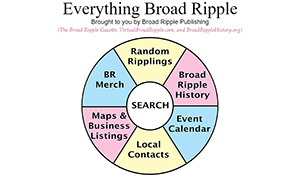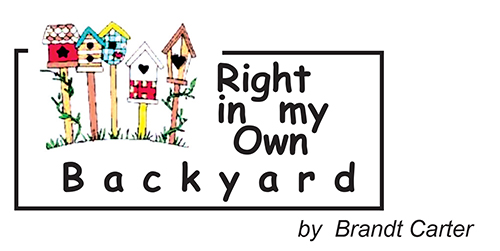
|
Broad Ripple Random Ripplings

The news from Broad Ripple
Brought to you by The Broad Ripple Gazette
(Delivering the news since 2004, every two weeks)

|
| Brought to you by: |

|

|

|

|

|

|
Converted from paper version of the Broad Ripple Gazette (v11n04)
Right in my Own Backyard - Anchor In Our History - by Brandt Carter
posted: Feb. 21, 2014

Anchor In Our History
It's history review time. I think we always need to know what has gone before to better understand today and beyond. So let's look at the hardy influences that gave rise to this amazing community ― Broad Ripple.
You may have heard the story, but I am going to take it from another slant. . . the spirit that gave shape to this community. Indianapolis was founded in 1821 by an act of the Indiana General Assembly and replaced Corydon as the new seat of government January 1, 1825. Prior to its official founding, Indianapolis was a swampy area called the Fall Creek Settlement, sparsely settled by fur traders.
While Indianapolis was situating as the capital, Broad Ripple was also taking form. In 1822 the land in this area was purchased from the U.S. government. Jesse McKay and John Calip [Colip] acquired 147 acres, and Jonas Huffman took possession of 60 acres. Settlers came to the area on the White River by flatboats loaded with household goods. The shallow ripples of the White River served as a popular crossing for travelers, merchants, and settlers.
The late 1830s were a boom time for our community. Divided by the canal, Broad Ripple was on the north and Wellington on the south. Homes, grist mills, saloons, grocery and general stores sprung up as the two communities sparred and competed. Fourteen years after the grand bill was passed, there were enough people to need a post office. It opened in 1850 and was moved back and forth between the two communities until 1884. Some 34 years later the permanent location was moved to Wellington, and the two communities became Broad Ripple with a total of 150 residents. McKay, Calip, Coil, and Nelson were some of the names of movers and shakers of the times.
During this era there were some wild, unsavory characters who probably contributed to residents wanting churches. The first churches were populated by Presbyterians, Baptists, and Quakers. The community built a common building called the Union Church (on the site of the fire station at 6330 Guilford). This large, wood structure served as the church facility for all denominations at one time. The Methodist Episcopal Church met in that building after establishing a class in Broad Ripple in 1852. It was originally part of the Allisonville Circuit. The Castleton Methodist Church preceded the Broad Ripple Church.
Churches during those times had circuit preachers who held big camp meetings and revivals. Hymn singing, sermons, Sunday school, and saving lives from wandering ways were part of the religious life of the area. Methodists and Quakers, with anti-slavery sympathies in common, aligned. If you want to read a complete history of Broad Ripple United Methodist Church, you can find an in-depth document online, "One Hundred Fifty Years in Broad Ripple, Celebrating Methodism's Outpost for Preaching the Gospel in Broad Ripple."
Spirit and the spiritual are still part of our community. Check out the Directory of the Gazette and you will find 22 places of worship listed. This guide can be helpful when you are looking for a location for a wedding, a funeral, or a place to find fellowship. If you are trying to find a faith connection, visit one of our local churches. They are an important thread in our history.
Brandt Carter, artist, herbalist, and naturalist, owns Backyard Birds at 2374 E. 54th Street. Visit her web site www.feedbackyardbirds.com. Email your bird questions to Brandt@BroadRippleGazette.com
brandt@broadripplegazette.com

|

|

|
| Brought to you by: |

|

|

|
| Brought to you by: |

|

|

|
| Brought to you by: |

|

|

|
| Brought to you by: |


